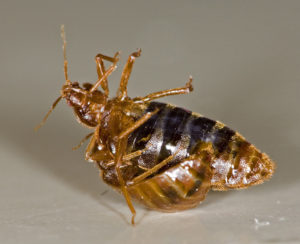
You may have seen the anglerfish sex video floating around the Internet recently, with titles like “The worst sex in the world is anglerfish sex, and now there’s finally video.” While the video is worth a watch, I think most behavioral ecologist would beg to differ with the main assertion: there’s a lot of bad sex in the animal kingdom.
Why is anglerfish sex supposedly so terrible? A male anglerfish bites a females when he finds her, and then hangs onto her for the rest of his life, essentially turning into a living sac of sperm. But hey, at least he’s alive. In contrast, some species of male widow spiders somersault into the mouths of females as they mate, impaling themselves on their mates’ fangs. It sounds like an evolutionary enigma–why would an organism ever willingly sacrifice itself?–but turns out that that self-sacrifice can increase a male’s chances of fathering the female’s offspring.

“Traumatic insemination” is another great example of not-so-great sex. In this case, bed bug females are the ones getting royally screwed, because traumatic insemination is a nice way of saying males stabbing females through the abdomen with their penises. The sperm then travels through the female’s hemolymph (the insect equivalent of blood), until reaching the ovaries and fertilizing the eggs. Males mate with all available females, because the last male to mate with any given female has the best chance of fathering her offspring. However, females who are subjected to these multiple matings pay a high cost: they have shortened lives and reduced reproductive output, because they have to allocate energy to healing the wounds and dealing with any resulting infections.
People often assume that two organisms mating with one another have the same “goals.” After all, both males and females are presumably invested in having as many healthy offspring as possible. But this is only true up to a certain point. Female widow spiders don’t need males to remain alive after mating, and in fact gain an advantage from eating the male (a ready source of nutrients that will help her with her next clutch!). In contrast, male widow spiders obviously benefit from not being eaten, and instead living to mate another day. Similarly, mating multiple times via traumatic insemination is costly to female bed bugs, who only need enough sperm to fertilize their eggs, while male bedbugs benefit from mating as many times as possible.
These are examples of what biologists call sexual conflict. While the source of conflict is obvious in the widow spiders’ and bed bugs’ cases, sexual conflict occurs anytime male and female genetic interests don’t align. In fact, the only time there is absolutely no potential for conflict is when males and females have exactly the same lifetime reproduction, so that each is equally invested in all of their shared offspring, with no opportunities for having offspring with other partners. In contrast, conflict can arise whenever one sex has the opportunity to improve their chances of having more, or better, offspring. This can happen in many different ways, such as: eating your partner, mating multiple times with the same partner, or even mating with multiple partners.
As a result, sexual conflict isn’t likely in anglerfish, at least those species which only have one mate for their entire lives. Although there are genera of anglerfish where females can have up to 8 males hanging off of her! So there’s potential for sexual conflict there, since the males will presumably compete to father her offspring and could do so in ways that are harmful to the female. However, anglerfish are incredibly hard to study because they generally occur in the deep sea. Frankly, male anglerfish have way more going for them than you might’ve ever thought–keep that in mind next time someone’s making fun of them.
Peer edited by Karen Setty.
Follow us on social media and never miss an article: